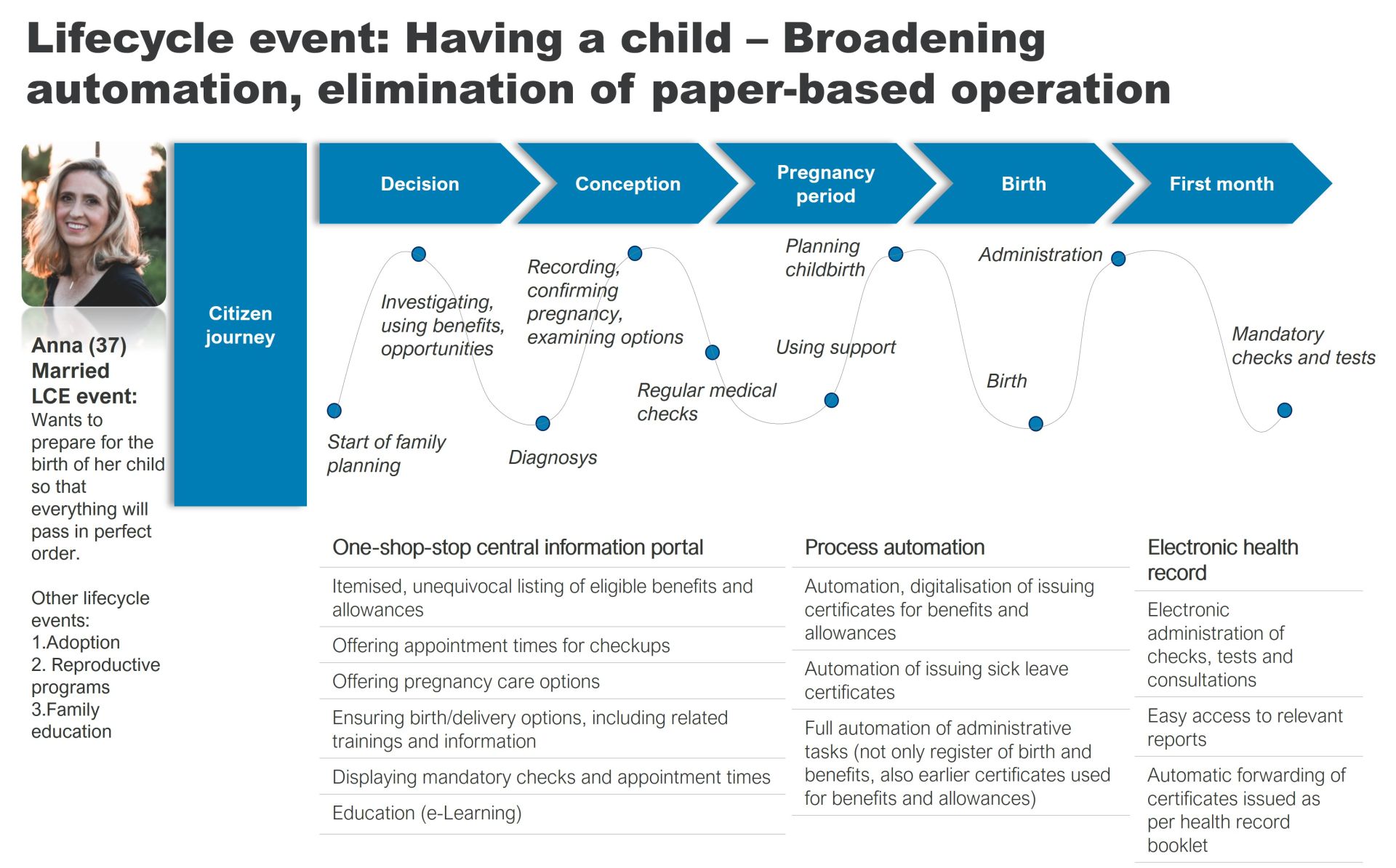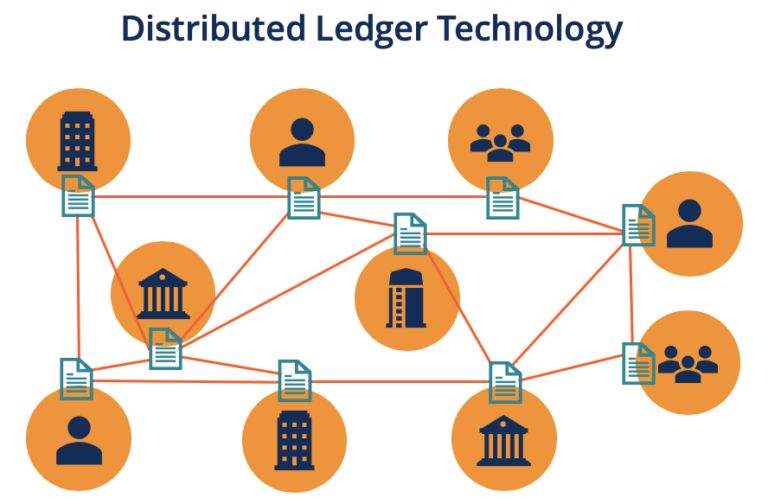Article
9 min read
Is public administration winning the race against the competitive sector in digitalisation?
Digital transformation is the process when an institution or company, building on revolutionary, new digital technology and business opportunities, fundamentally redesigns its operations based on changed customer needs, and thus moves away from the constraints of traditional operations to provide better service and achieve price advantage.

Citizen lifecycle event-based approach
Digital transformation is the process when an institution or company, building on revolutionary, new digital technology and business opportunities, fundamentally redesigns its operations based on changed customer needs, and thus moves away from the constraints of traditional operations to provide better service and achieve price advantage. The culture of digialisation and mobile-based administration places an inescapable burden on service providers to digitally transform their operations. The state and its institutions responsible providing for civil services are no exception to this rule, as the digitalisation of public administration has by now become a justified public expectation.
A citizen lifecycle event-based approach will soon replace and win over perplexing, obscure administrative mazes, long response times, and in-the-flesh personal encounter administration. Why not organise the launch of each case around a citizen lifecycle event, use the data already entered a thousand times to fill in forms, or perhaps have institutions automatically notify each other of changes. This will be the approach to the new government public services.
Childbirth - digitally transformed
Digital transformation forces a change of mindset and results in customer focus. Everything becomes both more meaningful and simpler, and the people doing the transformation for the right cause are much easier to motivate.
The birth of a child in a family is a memorable thing. But only to the instant when the bitter-tasting labyrinth engineered by certain institutions turns into a calvary to walk for the parents; heaven forfend, i.e., the child's name is noted in the civil register incorrectly. In the citizen life event-based approach, the digital and automated process launched from a single interface and coupled with data uploading makes the matters to be dealt with tied in a bundle that is transparent and easy to understand.
A couple having a child is not intent on submitting a marriage certificate or paternity declaration, but would prefer to receive the relevant documents of their newborn infant. Instead of waiting for filed applications, and managing the information in its possession, the competent state office can equally initiate the process automatically, as the data required to complete the procedure are available. This means that upon requesting a newborn child's documents there is no need to submit the corresponding marriage certificate in person, because the latter is already available at the office, and people could dispense with one-to-one personal encounters because mobile administration is so obvious, straightforward and process-driven. Obviously, not only this simple showcase issue can be readily solved with this approach, but in fact the majority of cases related to a particular lifecycle event, in this case the birth of a child and becoming a parent.

The transformation seen from the inside
Government services need to be managed at a comprehensive level similar to that of a large enterprise, including the business operating model, the related services, underlying IT service applications, management of stored and processed data, and not forgetting the physical infrastructure (TOGAF architecture design methodology).
Creating digital citizenship requires a change of paradigm in the way institutions regard government services, so that cumbersome administration can be replaced with automated government services. The digitalisation of public administration is based on the lifecycle events of citizens, transforming and completely redefining the way the administration is done by connecting different institutions, offices of competence and jurisdiction, the operation of public and market service providers, and the data sets and processes they hold, creating a whole new ecosystem with the citizen at its heart.
This approach is by no way new, in fact, the competitive sector has used the Customer Journey-based methodology to support customer experience for some time. Its presence is still limited in the public sector, but there are already good practices in this industry around the world: Estonian citizens for instance can register the birth of a child online, and then the system automatically determines and issues entitlements to eligible benefits based on the parents' income and employment status.
Institutions are linked to the concept of digital citizenship in such a way that different (public and private) institutions need to rely on each other both to secure the availability and accuracy of data and information, and to ensure the smooth handling of the citizen's lifecycle events and career by providing transitions between contact points.
In the background, data query should be ensured by the Register of Assignments. The RoA (ÖNY) is a Central Electronic Administrative Service (KEÜSZ) designed to ensure the interoperability of registers authorised to manage identification codes and identification data. When requesting data, the relevant players must make use of the Central Identification Agent (KAÜ) and the Central Government Service Bus Regulated Electronic Administrative Service (KKSzB SZEÜSZ).

Who should be responsible for citizen lifecycle events?
Cross-institutional governance, a comprehensive regulatory environment, and the coordination of development projects are the biggest challenges and success criteria for digital transformation.
In terms of governance, an over-arching institutional management structure, project management and implementation are required to ensure that the needs of different stakeholders are satisfied. User experience can be enhanced through simple, transparent interfaces, customer-centered navigation, and a streamlined, straightforward administrative process: In the citizen lifecycle event of having a child, parents have to be guided through the different phases of their lifecycle event (decision, conception, pregnancy, etc.) in the simplest possible way.
In the context of using data assets, the data strategy of public and private institutions linked to the new/altered digital ecosystem and the scope of the data used, the interoperability of national data assets concerned, and the possibility of extending external data connections should be reviewed, as this data connection map may change depending on the objectives. Part of the construction of the legislative environment pillars is the disposition over citizens' data, their interconnection, the channels of access to data and the technologies used.
The digital citizen must be protected when using the service - for example, the confidentiality of the data recorded is essential when having newborn children. In the background, IT systems must guarantee the triple maxim of availability, integrity and confidentiality, and the applicable legislation must create the conditions for the full legal protection and self-determination of citizens' data.

Control, technology and fundamentals
In addition to establishing the appropriate legal and technical conditions, the key to success is to build confidence between citizens and the government, and to educate individuals to become digital citizens.
The Government resolution aiming at launching the Digital Welfare Program stipulates that in compliance with the National Infocommunications Strategy (NIS) and the National Digital Development Program (DNFP), building on the results of the former, the DWP should nurture laying the cornerstones of the digital government, including the consolidation and further development thereof in accordance with the provisions set out in the associated DWP 2.0. Action Plan.
The government's objective regarding the DWP was to bring together educational stakeholders, citizens, employees and ventures to prepare and outfit them for the transition to the digital age. This objective has been successfully met, regarding the national data assets the digital state has been created, providing the prerequisites for digital citizenship and citizen lifecycle event-based public administration.
In achieving this, on the one hand, the unspoiled integrity and availability of central government public databases, and on the other hand, the technological solution for verifying authentic data, known as DLT - Distributed Ledger Technology-, i.e. multi-cloud block-chain distributed general ledger technology can be the source of attested, authentic data. The architecture provides a heterogeneous, multiple-unit, cloud-based DLT network. Organisations and stakeholders involved in the service can operate their nodes anywhere and still remain parts of the authenticated network with the aid of the open-source code Blockchain Automation Framework (BAF), providing a live DLT network solution on public and private cloud-based infrastructures.
Further steps of the implementation include the creation of a central catalogue of citizen lifecycle events, prioritisation of lifecycle events according to different criteria, and definition of programs based on these rules, which allow the extension of the digital state's tasks and the creation of digital citizenship.

List of lifecycle events

About authors

Eszter is a Business, IT and management consultant, certified customer experience expert. She has nearly 10 years of experience in providing consultancy support and leadership in customer experience improvement, process improvement, organisational transformation, quality assurance, IT projects. Her extensive expertise gained primarily in the financial services, technology, and telecommunications industries.

Throughout his nearly 30-year career in IT, Zoltán has led complex EU-funded and domestic projects. For 20 years, he worked in the private sector as an engineer and later as a manager. Over the past decade, he has focused on public administration informatics, previously heading departments at the Central Office of the Ministry of the Interior, the Public Employment Department of the National Employment Service (KEKKH), and the Labor Market Informatics Directorate of NISZ, gaining extensive experience in developing and operating key regulatory systems of central public administration. For 5 years, he served as the national leader of the EU/EC EURES IT working group, delegated by the Ministry of the Interior and the Ministry of National Economy. At Stratis, as a senior consultant between 2021 and 2023, he contributed over three years to the E-Health & E-Government sector.

